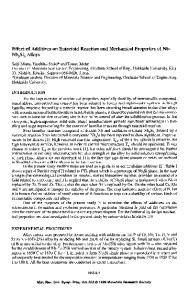On the Kinetics of Nb 5 Si 3 Compound Formation
- PDF / 1,717,826 Bytes
- 7 Pages / 420.48 x 639 pts Page_size
- 21 Downloads / 360 Views
ON THE KINETICS OF Nb5 Si3 COMPOUND FORMATION
Jan Kajuch, John W. Short, Changqi Liu and John J. Lewandowski Dept. of Materials Science and Engineering Case Western Reserve University, Cleveland, OH
ABSTRACT The kinetics of intermetallic Nb5 Si 3 compound formation via the mechanical alloying process was investigated. Interrupted milling process, X-ray diffraction, SEM examination and TEM imaging and diffraction were utilized to characterize changes in the milled powders, while DTA analyses were used to determine the critical and onset temperatures of reaction as a function of milling time. On the basis of experimental results, a kinetic model was proposed for formation of Nb5Si 3 via the interrupted MA process. It is suggested that precipitation of NbsSi 3 particles during cooling in the interrupted milling process is responsible for the exothermic reaction after resumption of milling.
INTRODUCTION Mechanical alloying (MA) is a simple but effective process for the production of intermetallic compounds of high temperature refractory metals. Its main advantage as compared to the standard melting and casting process is in the capability to maintain exact composition (stoichiometry), low degree of contamination, and flexibility in producing monolithic and composite powders. MA is a non-equilibrium processing technique analogous to Rapid Solidification (RS). In contrast to the RS process, the MA process is entirely a solid state operation at or near room temperature. The MA process has been defined as a dry, high energy ball milling process that produces composite metal powders with extremely fine microstructures. Interdispersion of the powders occurs by the repeated cold welding and fracturing process of free powder particles, trapped between two colliding steel balls'. The force of the impact deforms the particles and creates atomically clean surfaces which weld together on contact. To prevent oxidation of these surfaces, the milling operation is carried out in an inert gas atmosphere. Refinement of the structure is approximately a logarithmic function of time and depends on the mechanical energy input into the milling process and the work hardening of the powders being processed 2. The microstructural refinement continues into the steady-state period despite the fact that the hardness saturates and a constant agglomerate particle size distribution is achieved. Several authors studied the formation of intermetallic compounds by the MA process. Atzmon determined the parameters affecting phase formation in the Al-Ni system. While NiAl formed by an explosive, self-propagating reaction, Al 3Ni formed in a reaction with layer diffusion as a predominant factor. Kumar and his co-workers were the first to study the mechanism of MA in group V transition metal/silicon systems4 . In order to study the progress of mechanical alloying, the ball mill was stopped periodically and cooled to room temperature in order to enable removal of small amounts of the powder for analysis. This "interrupted process" resulted in the formation
Data Loading...











